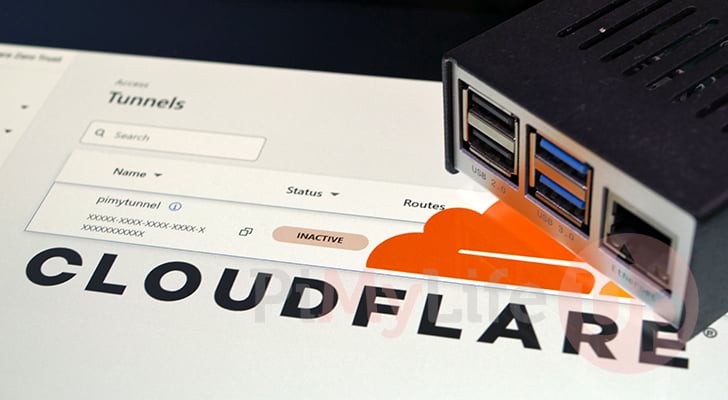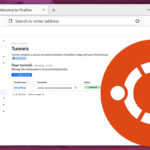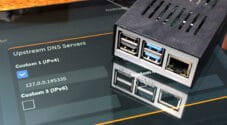This project will show you how to set up the Cloudflare tunnel on the Raspberry Pi.

Cloudflare is a company that has become well-known for its DDOS protection services. However, it is also one of the leaders in providing secure and private connections.
One of the products that Cloudflare offers for free is its tunneling service. This tunnel allows you to create a secure connection between your device and the Cloudflare network.
Using Cloudflare’s tunnel on your Raspberry Pi, you don’t have to worry about opening any ports in your firewall. If you want to give access to a service that uses HTTP or HTTPS, you won’t even need Cloudflared installed on another device.
Please note that this guide requires you to have a domain name configured to run through Cloudflare’s services. If you don’t already have a domain name setup, you will need to do this before continuing.
Equipment
Below is a list of the equipment we used when setting up a Cloudflare tunnel on the Raspberry Pi.
Recommended
Optional
This tutorial was last tested on a Raspberry Pi 5, running the latest version of Raspberry Pi OS Bookworm.
Video
You can check out our video embedded below that will walk you through the steps of setting up a Cloudflare tunnel on your Raspberry Pi. Otherwise, if you prefer written instructions, you can skip to the next section.
Preparing your Raspberry Pi for the Cloudflare Tunnel
To set up the Cloudflare tunnel on the Raspberry Pi, we will rely on a piece of software called “Cloudflared“. Cloudflared is the software that creates and maintains the secure tunnel between the Pi and the Cloudflare network.
While these steps are relatively straightforward, we will need to add the official Cloudflare repository to install the required software.
Installing any Required Software
1. Our first task is to perform an update of the package list as well as upgrade any out-of-date packages.
You can perform both of these tasks using the following command in the terminal.
sudo apt update
sudo apt upgradeCopy2. Once the update completes, we must ensure we have both the “curl” and “lsb-release” packages.
Install both of these packages by using the command below in the terminal.
sudo apt install curl lsb-releaseCopycurl– We will use curl to grab the GPG key for the Cloudflared repository.lsb-release– This package allows us to easily retrieve information about the system, such as the release name.
Adding the Cloudflare Repository on the Raspberry Pi
3. With all the required packages in place, we can finally grab the GPG key for the Cloudflared repository and store it on our Raspberry Pi.
To save this key to your device, use the following command.
curl -L https://pkg.cloudflare.com/cloudflare-main.gpg | sudo tee /usr/share/keyrings/cloudflare-main.gpg >/dev/nullCopyA GPG key is crucial to verify the packages we are installing are valid and belong to the repository.
4. With the GPG key saved into our keyrings folder, our next step is to add the Cloudflared repository to our Raspberry Pi.
You can add the repository by running the command below.
echo "deb [signed-by=/usr/share/keyrings/cloudflare-main.gpg] https://pkg.cloudflare.com/cloudflared any main" | sudo tee /etc/apt/sources.list.d/cloudflared.listCopy5. As we have made changes to the available repositories, we will need to perform another update of the package list cache,
You can update this cache by using the following command within the terminal.
sudo apt updateCopyInstalling Cloudfared on the Raspberry Pi
6. With the repository added, we can now proceed to install the Cloudflared package to our Raspberry Pi.
To install this package, you will want to run the following command.
sudo apt install cloudflaredCopySetting up a Cloudflare Tunnel on the Raspberry Pi
Now that we have prepared our Raspberry Pi, we can set up the Cloudflare tunnel. This tunnel is where your traffic will be run over
Authenticating with the Cloudflare Service
1. Our first step is to create an association between our Raspberry Pi and the Cloudflare service.
We can begin authenticating with the Cloudflare service by using the command below.
cloudflared tunnel loginCopyEnsure you keep Cloudflared open on your device while this process is completed.
2. After running the above command, you will see the following message appear within the terminal.
You will want to go to the URL displayed in the message and use it to log in to your Cloudflare account.
Please open the following URL and log in with your Cloudflare account:
https://dash.cloudflare.com/argotunnel?callback=https%3A%2F%2Flogin.cloudflareaccess.org%2FXXXXXXXXXX
Leave cloudflared running to download the cert automatically.3. Once your Raspberry Pi is successfully authenticated with the Cloudflare service, you will see the following message.
You have successfully logged in.
If you wish to copy your credentials to a server, they have been saved to:
/home/pi/.cloudflared/cert.pemCreating the Cloudflare Tunnel on the Raspberry Pi
4. Now that we are authorized, we can create a Cloudflare tunnel by using the following command.
Ensure you replace “TUNNELNAME” with the name you want to assign this tunnel.
cloudflared tunnel create TUNNELNAMECopy5. After running the above command, you will see a message similar to the one below.
You will want to write down the ID as we will need this for later.
Tunnel credentials written to /home/pi/.cloudflared/XXXXXXXX-XXXX-XXXX-XXXX-XXXXXXXXXXXX.json. cloudflared chose this file based on where your origin certificate was found. Keep this file secret. To revoke these credentials, delete the tunnel.
Created tunnel pimytunnel with id XXXXXXXX-XXXX-XXXX-XXXX-XXXXXXXXXXXXRouting the Tunnel to a Domain Name
6. With the tunnel created, we can now route the tunnel to a domain name that we have with Cloudflare. This will allow us to access our Raspberry Pi through that domain name.
For example, if you wanted your Minecraft server or PhotoPrism to be accessible through a particular domain name, you can use the following. However, if the program you want to create a tunnel for doesn’t use the HTTP or HTTPS protocol, the other user will need to have Cloudflared installed.
Ensure you replace “TUNNELNAME” with the name of your tunnel and replace “DOMAINNAME” with the domain name you want to use.
cloudflared tunnel route dns TUNNELNAME DOMAINNAMECopy7. If the above command worked correctly, you would see a similar message to the one below. This message confirms that Cloudflare created a CNAME that routes to your tunnel.
2022-10-18T04:54:54Z INF Added CNAME DOMAINNAME which will route to this tunnel tunnelID=XXXXXXXX-XXXX-XXXX-XXXX-XXXXXXXXXXXXForwarding your Raspberry Pi Ports through the Cloudflare Tunnel
8. The final task we need to do is connect the Cloudflare tunnel to a destination on our Raspberry Pi.
While the tunnel exists, it isn’t currently linked to anything, so in this example we will be putting it to a specific URL.
When running this command, replace “PORT” with the port belonging to the app you want to expose. For example, if you want to expose the HTTP port of your web server, you can use port 80.
Replace “TUNNELNAME” with the name of the tunnel.
cloudflared tunnel run --url localhost:PORT TUNNELNAMECopy9. Once the Cloudflare tunnel has been started, you will see a message similar to the one below.
2022-10-18T09:34:40Z INF Starting tunnel tunnelID=XXXXXXXX-XXXX-XXXX-XXXX-XXXXXXXXXXXX
2022-10-18T09:34:40Z INF Cannot determine default configuration path. No file [config.yml config.yaml] in [~/.clouddflare-warp /etc/cloudflared /usr/local/etc/cloudflared]
2022-10-18T09:34:40Z INF Version 2022.10.0
2022-10-18T09:34:40Z INF GOOS: linux, GOVersion: go1.18.6, GoArch: arm
2022-10-18T09:34:40Z INF Settings: map[url:localhost:80]You can close this tunnel at any point by pressing CTRL + C on your keyboard.
10. To verify that your Cloudflare tunnel to your Raspberry pi is working, you should now try accessing it through the domain name you set up earlier.
For example, we set up a Cloudflare tunnel for our NGINX web server and accessed it through that.
Connecting to your Cloudflare Tunnel on Boot
11. Once you have verified that your Cloudflare tunnel works, you will likely want it to be started when your Raspberry Pi starts.
To do this, we will have to write all of this within a “config.yml” file that the Cloudflare daemon will read.
sudo nano ~/.cloudflared/config.ymlCopy12. Within this file, you will want to type in the following lines and adjust them for your use case as you go.
[TUNNELNAME]– Replace this value with the name of your tunnel.[USERNAME]– This value will need to be replaced with your user’s name.[UUID]– You will need to specify the UUID that you got back in step 5 of this section.[HOSTNAME]– Swap this value out with the domain name you are planning to utilize. For example, “test.pimylifeup.com“.[PORT]– Finally, replace “PORT” with the port you want accessible through the tunnel.[PROTOCOL]– This is the protocol you want tobe utilized for your service. In the case of a web server, you will want to use “http” or “https“.
However, there are a few other options that you can utilize if the service you are using utilizes a different protocol.http– Forward HTTP requests through to the specified service.
E.G.,http://localhost:8080https– Forward HTTPS requests to the specified service
E.G.,https://localhost:8080
unix– Same as HTTP but using a Unix Socket.
E.G.,unix:/home/example/exam.sockunix+tls– Same as HTTPS but utilizing a Unix socket.
E.G.,unix+tls:/home/example/exam.socktcp– Proxy a service using the TCP protocol to a local service. (For example, a Minecraft server)
E.G.,tcp://localhost:25655ssh– Allows you to proxy an SSH connection to a local service.
E.G.,ssh://localhost:22rdp– Proxies a connection made using RDP to the specified service.
E.G.,rdp://localhost:338
tunnel: [TUNNELNAME]
credentials-file: /home/[USERNAME]/.cloudflared/[UUID].json
ingress:
- hostname: [HOSTNAME]
service: [PROTOCOL]://localhost:[PORT]
- service: http_status:404Copy13. Once you have made these changes within the config file, save and quit by pressing CTRL + X, then Y, followed by the ENTER key.
14. With the config file created, we can install it as a service using the following command.
This command will copy our config file to the correct location and prepare a service file for systemd.
sudo cloudflared --config ~/.cloudflared/config.yml service installCopy15. We can enable the Cloudflare tunnel service so that it will start when our Raspberry Pi does by using the following command.
sudo systemctl enable cloudflaredCopy16. Finally, you can ensure the tunnel is online now by using the command below within the terminal.
sudo systemctl start cloudflaredCopyConclusion
This tutorial shows you how to set up a Cloudflare Tunnel on the Raspberry Pi.
A Cloudflare tunnel allows you to create a secure connection to the Cloudflare network without having to open ports on your host machine.
If you only want to serve from HTTP or HTTPS, then you don’t need Cloudflared installed on the client machines.
Please comment below if you have had any issues getting the Cloudflare tunnel running on your Raspberry Pi.
Be sure to check out our many other Raspberry Pi projects, such as our guide on running Tailscale on the Raspberry Pi.










Apt sources have changed
See
https://pkg.cloudflare.com/index.html#debian-anyHi James,
Thanks for the heads up about that. I have updated ours to now put to the “any” repository rather than using the OS release name.
Kind regards,
Emmet
With respect to a domain name, I use noip service which lets me use one of their predefined domain names, for example quicksytes.com that I customized to myrpi1.quicksytes.com. The domain name gets mapped to the IP address of my computer. Will cloudflare work with my noip redirect setup?
Are there any potential ‘gotyas’ that I need to be aware of if I use the cloudflare approach?
These approaches rely on services outside of my control, if cloudflare goes away or becomes a paid service (and I don’t want to pay) I’ll be screwed. Any other approach that is totally under my control?
Thanks
Hi John,
Unforutnately you can’t use the free domain names that noip offers with Cloudflare. With Cloudflare you need control over your domain name so that you can route it through their nameservers. You can kind of replicate what no-ip does using Cloudflare but again you would need to have your own domain name still.
There are a few weird bits in the terms and conditions with the Cloudflare Tunnel that always makes it a bit of a risk to use. Basically if you are using it for anything data intensive like Plex, there is always a chance your account will get restricted. I haven’t seen that happen to many people but have seen others point it out.
If you wanted to retain control over the entire stack and not rely on Cloudflare Tunnel, the closest tool to use would be Pangolin. However, that would require you to invest in a VPS to host the Pangolin controller and give you easier outside access.
Kind regards,
Emmet
hi Emmet
i realised that having CNAME [mydomain].com in cloudflare was the problem. once i deleted that the tunnel forwarding worked as it was supposed to.
thanks
When you put in your domain does it need this in front, rather than the XXXXXXX.com?
Thanks, I tried with Chatgpt and was on the edge of success for hours 🙂
Hi David,
You just enter the domain name that you intended to use. So, if it was “
test.pimylifeup.com” you would use that, if it was “pimylifeup.com” you would use that.Please let me know if you need a better explanation. I have definitely found ChatGPT and Claude and co to be very hit and miss, would almost get you there then either miss a step entirely or invent up steps entirely.
Kind regards,
Emmet
Thanks Emmet. I thought that was the case, without the www. etc. Cloudflare created the cname at that url, the tunnel seems to be working fine but the url doesn’t deliver on the web.
Hi David,
When running the
cloudflared tunnel runcommand, have you verified that you are specifying the correct port to your web app?Kind regards,
Emmet
Hi Emmet
Thanks for bearing with me, I used port 80 as you did in the tutorial. It was a bit of a punt! Is there a way of finding/knowing exactly the port I need to go through? I presumed that would open up the wordpress site to the web.
Hi David,
Assuming you have a typical setup and are just using Nginx / Apache as your web server then you should be correct in using port 80. I assume your “
service:” line looks a bit like the following?From memory, you should be able to actually check the status of your tunnel, and the connection attempts through the Cloudflare web interface. It might be worth having a look to see if there is any useful error messages being thrown.
If you aren’t adverse to spending a little bit every month, an alternative option to using Cloudflare Tunnel is to use Pangolin. Its like an open-source alternative to Cloudflare Tunnels but does involve having to run the main Pangolin software on a VPS/Server of your own, so has that extra cost. It’s currently what im doing as I found it a bit easier to manage then a Cloudflare Tunnel.
Kind regards,
Emmet
Did a SSH Tunnel to my Raspberry Pi. Worked like a charm 🙂
Does this guide also apply to Fedora based linux machines?
Hi Alexander,
The tutorial would need several changes for it to work on Fedora. Feodra uses a different package management system that would require you to setup the RHEL RPM repository for the Cloudflare instead.
Kind regards,
Emmet
Thank you very much. Worked great!
I am having issues with step #2 under heading, “Authenticating with the Cloudflare Service.” I am connecting from my Windows PC to my Raspberry Pi 2 via the KiTTY SSH tool. I am having issues copying the URL from the SSH window. Is there a different SSH tool you recommend and what am I doing wrong?
Hi Wzrdcrv,
I used to use a tool called mobaxterm and always found that to be a decent solution for handling SSH. These days however, I like to just use SSH straight from the terminal.
So you can open a SSH session within the Windows by just using like “ssh pi@192.168.0.123“. Where “pi” would be your username and “192.168.0.123” would be your Raspberry Pi’s IP.
Some of these tools do make opening up links from a terminal easier by allowing you to “ctrl” + Click it within the interface.
Kind regards,
Emmet
Excellent tutorial, thank you a lot! 🙂
thanks, totally helpful and straight-forward. ✌️
Thank you so much ! That is exactly what I was looking for and better than all other alternatives
Still fully working and valid today
Only thing id add is enforcing https through the domain and ssl/tls areas
After spending 2 days finding an issue with chatGPT, I remembered that I bought your PDFs a few years back. This article solved my problem in 15 min 🙂 Thank you so much!
This is exactly what I was looking for! Thank you!
Thank you so much this was soooo perfect, made my day!! I had been struggling so much.
Thank you so much for the tutorial. It’s working great!
Great guide, however the function of the CloudFlare Tunnels is very limited. As it is not possible to host all the services we want. For example, as far as minecraft servers are concerned, this is not possible.
Eventually I ask if it is possible to deepen the guide also with UDP protocols, such as TeamSpeak Server, as it is of great interest!
Thank you